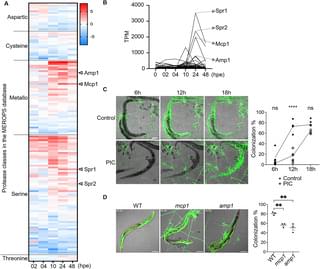Every year I compile what I think were some important contributions to longevity research. Here is my list for 2023.\
\
Find me on Twitter — / eleanorsheekey \
\
Support the channel \
through PayPal — https://paypal.me/sheekeyscience?coun… \
through Patreon — / thesheekeyscienceshow \
\
Intro — 00:00\
\
What causes aging? — 00:32\
Hallmarks Of Aging: An Expanding Universe \
The DREAM Complex Functions As Conserved Master Regulator Of Somatic DNA-Repair Capacities \
\
Biomarkers — 02:00\
The Aging Biomarker Consortium Represents A New Era For Aging Research In China\
Longitudinal fundus imaging and its genome-wide association analysis provide evidence for a human retinal aging clock\
A Foundation Model For Generalizable Disease Detection From Retinal Images\
\
Cellular reprogramming — 04:30\
Chemically induced reprogramming to reverse cellular aging\
Loss of epigenetic information as a cause of mammalian aging\
In vivo reprogramming leads to premature death linked to hepatic and intestinal failure\
\
Lifespan extension — 07:30\
Astaxanthin and meclizine extend lifespan in UM-HET3 male mice; fisetin, SG1002 (hydrogen sulfide donor), dimethyl fumarate, mycophenolic acid, and 4-phenylbutyrate do not significantly affect lifespan in either sex at the doses and schedules used\
Taurine deficiency as a driver of aging\
Dietary supplementation of clinically utilized PI3K p110α inhibitor extends the lifespan of male and female mice\
Optogenetic Rejuvenation Of Mitochondrial Membrane Potential Extends C. Elegans Lifespan\
Reversal Of Biological Age In Multiple Rat Organs By Young Porcine Plasma Fraction\
Multi-Omic Rejuvenation And Life Span Extension On Exposure To Youthful Circulation\
\
Biotechnology — 13:50\
Intravascularly infused extracellular matrix as a biomaterial for targeting and treating inflamed tissues\
Intradermally delivered mRNA-encapsulating extracellular vesicles for collagen-replacement therapy\
\
Why we age — 15:15\
Ageing as a software design flaw\
The Longevity Bottleneck Hypothesis: Could Dinosaurs Have Shaped Ageing In Present‐Day Mammals?\
Reconsidering Life History Theory Amid Infectious Diseases\
Blood Group A Enhances SARS-CoV-2 Infection\
\
What’s next? — 16:50\
\
There are many items missing from this list — these are only the papers I found time to read. Please post below any I missed! \
\
ICYMI\
\
2022 longevity papers\
\
2021 longevity papers\
\
Please note that The Sheekey Science Show is distinct from Eleanor Sheekey’s teaching and research roles at the University of Cambridge. The information provided in this show is not medical advice, nor should it be taken or applied as a replacement for medical advice. The Sheekey Science Show and guests assume no liability for the application of the information discussed.\
\
Icons in intro; \.
Category: sex – Page 9

Use Of AI In DeepFakes Accelerating Risks To Companies
Board directors and CEO’s need to increase their knowledge of Deep Fakes and develop risk management strategies to protect their companies. Deepfakes are videos or images that often feature people who have been digitally altered, whether it be their voice, face or body, so that they appear to be “saying” something else or are someone else entirely.
You may recall the trickery of the video in 2019 showing Tesla cars crashing into a robot at tech convention causing havoc or of Wayfair false information involved in child sex trafficking through the sale of industrial cabinets. Even Mark Zuckerberg has been inflicted by deep fakes from a video where he was allegedly thanking U.S. legislators for their inaction on antitrust issues.
Unfortunately, deep fakes are incredibly easy to produce having gone mainstream and with AI, there are even more accelerated risks to plan for.
Real Life SEX ROBOTS Are Coming — The Dangers Of Seductive AI
One of the early opportunities for Optimus to which Elon has alluded.
Disrupting prostitution, OnlyFans and the female profiteering off men’s emotional and sexual needs.
. Our guest, Mo Gawdat, former chief business officer for Google X, brings a stark warning from the forefront of technology. Having shaped the tech landscape through his work with IBM, Microsoft, and Google, Mo unflinchingly declares AI as a greater threat to humanity than global warming. The AI revolution is upon us, reshaping our future, irrespective of our stance. This episode delves into the startling implications of a world intertwined with sex robots. Could such artificial companionship eclipse our inherent need for human connection?
The Evolutionary Psychology Of Love
Robin Dunbar is an anthropologist, evolutionary psychologist, head of the Social and Evolutionary Neuroscience Research Group at the University of Oxford and an author. Love is something that people have been trying to describe for thousands of years. Beyond asking what love is, is the question of why humans feel something so strange in the first place. Why would evolution have exposed us to this extreme sensation with huge potential for catastrophe and pain? Expect to learn how love is adaptive, why humans need to have more sex than almost all other animals to get pregnant, why ancestral men who hunted big animals were only doing it to get laid, how the length of your fingers can tell you how promiscuous you are, whether Robin thinks humans were ancestrally monogamous and much more…
Understanding Relationships: Evolution’s Secrets
Dr Andrew Thomas is a senior lecturer of psychology at Swansea University whose research focuses on sex differences and relationship preferences from an evolutionary perspective. Evolution explains a large portion of why we like the things we like. Who we’re attracted to, why we fall into and out of love, how our mental state affects our mating strategies. Therefore, if you are a human who ever intends on being in a relationship, this might be useful. Expect to learn the 5 evolutionary theories which explain much of human mating, whether ChatGPT can correctly predict what traits men and women like most in each other, how many previous sexual partners people say they want their current partner to have had, how open men & women in the West are to polyamorous relationships, how sexual arousal can ruin a faithful relationship and much more… Sponsors: Get 20% discount & free shipping on your Lawnmower 4.0 at https://manscaped.com/modernwisdom (use code MODERNWISDOM) Get over 37% discount on all products site-wide from MyProtein at https://bit.ly/proteinwisdom (use code: MODERNWISDOM) Get 83% discount & 3 months free from Surfshark VPN at https://surfshark.deals/MODERNWISDOM (use code MODERNWISDOM) Extra Stuff: Follow Andrew on Twitter — https://twitter.com/DrThomasAG Get my free Reading List of 100 books to read before you die → https://chriswillx.com/books/ To support me on Patreon (thank you): https://www.patreon.com/modernwisdom #evolution #dating #psychology — 00:00 Intro 01:20 Evolutionary Mismatch 10:18 Evolving Towards Making Small Errors Instead of Big Ones 17:33 Are Men as Picky as Women? 21:55 Is Promiscuity Heritable? 27:32 Humans Engage in Multiple Types of Sexual Strategies 36:49 The Different Levels of Sexual Harassment 46:55 Is Sexlessness in Young Men Caused by Poor Social Skills? 52:56 Attitudes in the West to Having Multiple Sexual Partners 1:04:21 How Many Previous Sexual Partners is Too Much? 1:14:52 What ChatGPT Gets Wrong About Mate Preferences 1:34:31 Where to Find Dr Thomas — Get access to every episode 10 hours before YouTube by subscribing for free on Spotify — https://spoti.fi/2LSimPn or Apple Podcasts — https://apple.co/2MNqIgw Get my free Reading List of 100 life-changing books here — https://chriswillx.com/books/ — Get in touch in the comments below or head to… Instagram: https://www.instagram.com/chriswillx Twitter: https://www.twitter.com/chriswillx Email: https://chriswillx.com/contact/
Understanding the Biological Differences Between Men and Women
Dr Carole Hooven is Co-director of Undergraduate Studies in the Department of Human Evolutionary Biology at Harvard University and an author. Testosterone is a hell of a drug. It causes many things to happen in both men and women. But it’s dividing opinion even more than it’s dividing the sexes. This isn’t great for calming conversations, bridging differences or finding common ground however it’s a fascinating topic to dig into. Expect to learn what it’s like for women who go on testosterone to feel what male sex drive is like, why male deer in Scotland grow antlers and fight their best friends for a few months every year, whether maternal instinct is a myth, why testosterone even exists at all, the differences between male and female orgasms, whether sex is a spectrum and much more…
How Do Women Compete For Partners?
Joyce Benenson is a lecturer of Human Evolutionary Biology at Harvard University who’s research focuses on human social structures and sex differences in competition and cooperation. We’re often told that men are more competitive, more status-driven and more ruthless with rivals for potential mates. In reality doesn’t seem to be true, the difference is that women’s competition takes a more subtle, cynical and sophisticated route to drive away their competitors. Expect to learn how women compete for status, why women exclude more than men, why women who promote an egalitarian world are less charitable than you might think, how you can interfere with a rivals’ relationship without getting caught, the usefulness of gossip as an enforcement mechanism and much more…

Startup Working on Space Babies, But the Risks Are Grim
If humans intend to conquer the stars and spread civilization beyond Earth, we really need to figure out sex: can humans conceive and have babies in places such as Mars, where factors like high amounts of radiation and lower gravity could wreck the adult body, nevermind potentially hindering natural conception and deforming growing fetuses?
A growing number of researchers and entrepreneurs want to tackle those questions. Take this startup called Spaceborn United, which we’ve blogged about previously.
The company is still hard at work, according to new reporting from AFP, with the aim of having a baby naturally conceived and born on Mars in the future.

Higher Risk of Alzheimer’s in Women Linked to Immunity and Metabolism
Cleveland Clinic researchers analyzed genes and brain tissue of patients with Alzheimer’s and found that differences in brain immunometabolism – the interactions between the immune system and the ways cells create energy – may contribute to women’s increased risk for the disease and its severity.
The findings, published in Alzheimer’s and Dementia, offer important insight into developing sex-specific treatment and prevention options for Alzheimer’s disease, the sixth-leading cause of death in the United States.
“Our immune systems depend on communication between different cell types in our bodies, which are fueled by energy created from unique metabolic processes,” said Justin Lathia, Ph.D., vice chair of the Department of Cardiovascular and Metabolic Sciences and co-author on the paper. “As sex influences both the immune system and metabolic process, our study aimed to identify how all of these individual factors influence one another to contribute to Alzheimer’s disease.”

Key processes required for the different stages of fungal carnivory by a nematode-trapping fungus
Nutritional deprivation triggers a switch from a saprotrophic to predatory lifestyle in soil-dwelling nematode-trapping fungi (NTF). In particular, the NTF Arthrobotrys oligospora secretes food and sex cues to lure nematodes to its mycelium and is triggered to develop specialized trapping devices. Captured nematodes are then invaded and digested by the fungus, thus serving as a food source. In this study, we examined the transcriptomic response of A. oligospora across the stages of sensing, trap development, and digestion upon exposure to the model nematode Caenorhabditis elegans. A. oligospora enacts a dynamic transcriptomic response, especially of protein secretion–related genes, in the presence of prey. Two-thirds of the predicted secretome of A. oligospora was up-regulated in the presence of C. elegans at all time points examined, and among these secreted proteins, 38.5% are predicte.